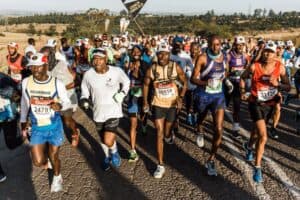It's essential to do lots of hill training, even if it's a so-called 'Down Run' to Durban this year.

Perched on a tall wooden scaffold near the summit of Cowie’s Hill on August 28, an eagle-eyed camera will be filming the progress of thousands of Comrades marathon runners as they battle their way towards the finish of the race in Durban.
It’s a particularly sadistic location for a camera because it will catch the runners at their weakest moments. They will have run over 70 kilometres of hills as they struggle up “Cowies”, navigate the bone jarring descents of Botha’s Hill, and Field’s Hill, and then they will have toiled through the sweaty humidity of Pinetown.
Most will have boasted to loved ones, friends and family that they will be running the Comrades marathon that day. But the all-seeing eye of the camera will clearly catch them walking the Comrades marathon, and not walking boldly and courageously, but rather shuffling, shattered, and vanquished. They will look anything but heroic.
Up and Down
Many runners, particularly novice runners, are seduced by the description “Down Run” and so, of the two directions in which the Comrades is run, the down run enjoys an undeserved popularity. Yes, the down run descends over half a kilometre to Durban’s Indian Ocean, and it is a little faster than the up run.
The “Up Run”, however, is made for runners, for athletes who can successfully battle fatigue as they haul their bodies up to Pietermaritzburg.
The “Down Run” is created for masochists. It’s about pain. It’s a teeth-gritting battle to ignore battered muscles, lifting toenails, and screaming quadriceps.
ALSO READ: Why the long run is so important
ALSO READ: A bridge too far?
ALSO READ: Do what I say, not what I do
ALSO READ: Key ingredients of a successful training programme
ALSO READ: An August run means May is the new March
As Max Trimborn’s cockerel crow and the starting gun’s report fade into the Pietermaritzburg dawn runners make their way through winter dark streets to the infamous Polly Shortts hill where they then plummet down to a frosty valley floor. Immediately they start to climb to Ashburton Village and as the veterans warn, “Because it’s the down run we go up” and that is precisely what runners do for the next few hours.
“Because it’s the down run we go up” to Ashburton, to Umlaas Road, up Harrison Flats, along the rolling hills to Cato Ridge and Camperdown, to the top of Inchanga, a short break while descending to Drummond, and then once again, because it’s the down run runners slog all the way up the 6-kilometre hill, to Botha’s Hill Village.
Then and only then does the down run live up to its name and become the “Down Run”.
Runners plummet down several precipitous descents that finally come to an end at the edge of the Indian Ocean. Sadly, this does not signal the end of the hills. Cruelly located along the headlong descent are a few more vicious climbs, which met by tenderised rubbery muscles can feel like a climb up Everest or the North Face of the Eiger.
Cowie’s Hill and its infamous TV camera is one such climb, 45th Cutting another, and the sheer concrete-lined 220 metre wall up onto the N3 highway yet another. In 2012 Zola Budd and I agreed to walk this one together, no matter how many camera lenses were pointing at us.
These warnings emphasise my point that specific hill training is essential for a successful down Comrades marathon.
We runners often try to avoid hills to make our runs as enjoyable as possible, but Comrades runners need to actively look for hills. Hills must become friends.
Runners need to train on short sharp hills and on long slow uphill climbs — exactly the terrain they will encounter in Comrades. My running friends in Swakopmund, Namibia, drive for 45 minutes, several times a week to run at Goanikontes, famous for its ancient rolling lunar-like hills.
Runners should work hard on the hills and at the summit of each hill run strongly “over the top” keeping the effort up. This builds tremendous hill strength and fitness.
I recommend running specific hill training sessions. My running and racing improved exponentially when my Wits University clubmates introduced me to the infamous Sweethooghte hill (Sweat Heights). This steep monster winds up to the base of Johannesburg’s Brixton tower.
We would warm up by running to Sweethooghte then we would sprint 5-8 times up this 410 metre hill, jogging back down to recover. This session was brutally hard, but it worked wonders. I credit weekly sessions on this hill with any success I may have achieved as a runner.
Sweethooghte was so important to me that I can still recall every tree that lined the road to the top and every crack in its gnarled old tar.
Why catch the lift to your office meeting on the 5th floor? Jog up the stairs and if you can find sets of stairs like the 207 steps in Westcliff that climb the Parktown Ridge and bound up them. That was another session that was crucial to my hill running.
The benefits of specific hill training are glaringly obvious, the results can be amazing and when adequately hill trained no Comrades runner should fear embarrassment on Cowie’s Hill. These fit runners will be able to understand that precisely because it’s the down run they will go up Cowie’s Hill, but they will run the hill full of confidence and full of smiles for the camera and for the thousands of impressed television viewers who will be watching their progress in awe.






